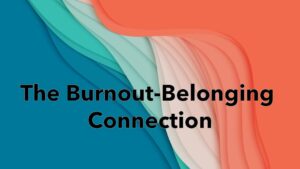Dr. Nunn has been studying belonging for over a decade. She is now offering a keynote from her upcoming book that leverages sociological wisdom about the dynamics of belonging to improve workplace communities.
Dr. Nunn’s new keynote on burnout and belonging.
We often hear the wrong message about burnout. That the way to avoid it is to change yourself: adjust your habits, declutter your calendar, take more time off, learn to “say no,” prioritize activities that rejuvenate you, and so on. While better time management and better boundaries are certainly good for us, they are not the solution to burnout. That’s because burnout is a community problem, not an individual one. Dr. Nunn’s Burnout and Belonging keynote brings insights from sociology to help us understand that it’s our workplaces—not ourselves—that need changing. She explains that the factors that create a feeling of belonging in a community are the very same things that, when absent, drive burnout. That’s the Burnout-Belonging Connection.
She offers strategies that you will reshape your workplace dynamics. The Burnout-Belonging connection is part of every community we are a part of and it is especially crucial at work.
Colleges and universities around the nation have utilized the insights and advice from Dr. Nunn’s research on student belonging. Your campus can request a talk or workshop on either or both of her recent books.

College Belonging reveals how colleges’ and universities’ efforts to foster a sense of belonging in their students are misguided. Colleges bombard new students with the message to “get out there!” and “find your place” by joining student organizations, sports teams, clubs and the like. Nunn shows that this reflects a flawed understanding of what belonging is and how it works. Drawing on the sociological theories of Emile Durkheim, College Belonging shows that belonging is something that members of a community offer to each other. It is something that must be given, like a gift. Individuals cannot simply walk up to a group or community and demand belonging. That’s not how it works. The group must extend a sense of belonging to each and every member. It happens by making a person feel welcome, to feel that their presence matters to the group, that they would be missed if they were gone. This critical insight helps us understand why colleges’ push for students simply to “get out there!” does not always work.
33 Simple Strategies for Faculty is an award-winning book. It starts with the reality that many student s struggle with the transition from high school to university life. This is especially true of first-generation college students, who are often unfamiliar with the norms and expectations of academia. College professors usually want to help, but many feel overwhelmed by the prospect of making extra time in their already hectic schedules to meet with these struggling students.
s struggle with the transition from high school to university life. This is especially true of first-generation college students, who are often unfamiliar with the norms and expectations of academia. College professors usually want to help, but many feel overwhelmed by the prospect of making extra time in their already hectic schedules to meet with these struggling students.
33 Simple Strategies for Faculty is a guidebook filled with practical solutions to this problem. It gives college faculty concrete exercises and tools they can use both inside and outside of the classroom to effectively bolster the academic success and well being of their students. To devise these strategies, educational sociologist Lisa M. Nunn talked with a variety of first-year college students, learning what they find baffling and frustrating about their classes, as well as what they love about their professors’ teaching.
Combining student perspectives with the latest research on bridging the academic achievement gap, she shows how professors can make a difference by spending as little as fifteen minutes a week helping their students acculturate to college life. Whether you are a new faculty member or a tenured professor, you are sure to find 33 Simple Strategies for Faculty to be an invaluable resource.

